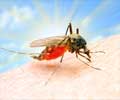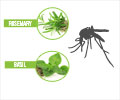
‘To control the spread of Rift Valley fever, long-term efforts are required as mosquito populations re-cultivate through different seasons.’
Tweet it Now
Unlike previous studies in this area, researchers examined the effect of seasonality and questioned how seasonally changing pools of water and air temperature impact on the spread of the fever. The spread of the disease increases if there is large number of infected mosquitoes, which is largely controlled by water levels and temperature. Using air temperature recordings from weather stations and satellite images, researchers were able to monitor the growth, location and lifespan of mosquito populations in Kenya. Researchers identified average levels of water areas and air temperature that can lead to the permanent removal of mosquito populations and Rift Valley fever.
For example it was discovered that, in a region of approximately 250 acres, the Culex mosquito population will always fade out when the surface area of water is under 1000m2 or if the temperature falls below 14 degrees Celsius. By comparison, if the annual surface of the water is 2000m2, then Culex mosquito's will disappear if the mean temperature is below 18 degrees or above 31 degrees.
Understanding more about mosquitoes and how their ecology is controlled by water areas and temperature is crucial to estimating the abundance of the mosquitoes and assessing how the disease spreads. This knowledge can help inform policy makers on the risk of disease in a particular area when deciding to build a new dam or changing their irrigation patterns.
Dr Gianni Lo Iacono, Lecturer in Biostatistics and Epidemiology at the School of Veterinary Science at the University of Surrey, said: "With increasing temperatures due to climate change, the patterns of vector borne diseases such as Rift Valley Fever will change and potentially become more of a threat to the general population.
Advertisement
"Learning more about the populations, and implementing methods such as carefully designing the patterns of irrigation, could help to reduce mosquitoes and Rift Valley fever infection."
Advertisement














